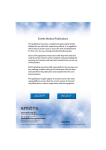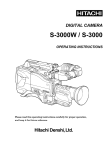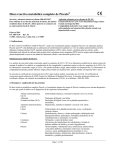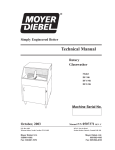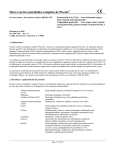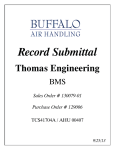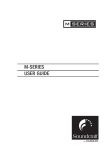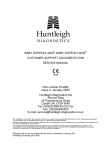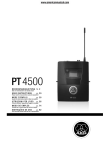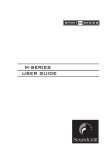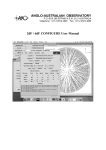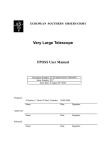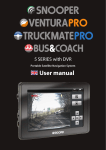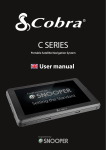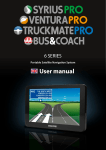Download 00SM-0113-6, Technical Service manual
Transcript
Smiths Medical Publications This publication has been compiled and approved by Smiths Medical for use with their respective products. It is supplied in this format to permit users to access the text and illustrations for their own use e.g. training and educational purposes. Users of the equipment must ensure that they have read and understood the contents of the complete manual including the warnings and cautions and have been trained in the correct use of the product. Smiths Medical cannot be held responsible for the accuracy and any resulting incident arising from information that has been extracted from this publication and compiled into the users documentation. This publication maybe subject to revision and it is the users responsibility to ensure that the correct version of manual/ text/illustration is used in conjunction with the equipment. Graseby ® MS26 Syringe Driver GM1282-A Technical Service Manual Part Number 00SM-0113F-6 Issue 6 (February 2005) © 2005 Smiths Medical family of companies. All rights reserved. MS26 Syringe Driver Smiths Medical Published by Smiths Medical. All possible care has been taken in the preparation of this publication, but Smiths Medical, accepts no liability for any inaccuracies that may be found. Smiths Medical reserves the right to make changes without notice both to this publication and to the product which it describes. Copyright © 2005 Smiths Medical family of companies. All rights reserved. No part of this publication may be reproduced, transmitted, transcribed, or stored in a retrieval system or translated into any human or computer language in any form or by any means without the prior permission of Smiths Medical. Smiths Medical MD, Inc. 1265 Grey Fox Road, St. Paul, MN 55112, U.S.A. European Representative: Smiths Medical International Limited Watford, Hertfordshire, United Kingdom, WD24 4LG http://www.smiths-medical.com Registered in England. Company number 362847 Trademarks and acknowledgements: “Graseby” and “Smiths” are trademarks of the Smiths Medical family of companies. All other trademarks are acknowledged as the property of their respective owners. Te c h n i c a l S e r v i c e M a n u a l Issue 6 (February 2005) Page i MS26 Syringe Driver Smiths Medical ISSUE RECORD Issue No. Reason for change Pages effected Date 5 Re-issue of Manual All May 2000 6 Lockbox and US variants added. All February 2005 February 2004 Page ii Issue 6 (February 2005) Te c h n i c a l S e r v i c e M a n u a l MS26 Syringe Driver Smiths Medical Scope of this manual This manual is for service personnel, enabling them to service and repair the MS26 Syringe Driver. It incorporates recent improvements, including Lockbox information, and the US variant. Related manuals This manual includes general operating information only. For detailed operating instructions, refer to the MS 16A Syringe Driver, MS 26 Syringe Driver Instruction Manual, (part number 01050549-A). Smiths Medical service contacts If you have any queries or problems that cannot be resolved by this manual, please contact the appropriate Service/ Repair Centre. UK address SMITHS MEDICAL INTERNATIONAL LIMITED. Repair Centre WATFORD WD24 4LG ENGLAND TEL: (+44) (0) 1923 246434 FAX: (+44) (0) 1923 447773 Web: www.smiths-medical.com USA service address MARCAL MEDICAL INC. 1114 BENFIELD BLVD, SUITE H MILLERSVILLE MARYLAND 21108-2540 TEL: (410) 987 4001 FAX: (410) 987 4004 Web: www.marcalmedical.com email: [email protected] Te c h n i c a l S e r v i c e M a n u a l Issue 6 (February 2005) Page iii MS26 Syringe Driver Smiths Medical Contents Chapter 1 - Product Overview Description ............................................................................................................. 1 Controls ................................................................................................................. 1 Operation ............................................................................................................... 1 Packed set ............................................................................................................. 1 Accessories and consumables ............................................................................. 1 - 3 4 4 5 6 Chapter 2 - Specification and Standards Specification .......................................................................................................... 2 - 3 Type ....................................................................................................................... 2 Infusion time ........................................................................................................... 2 Rate range .............................................................................................................. 2 Motor operating interval .......................................................................................... 2 Drive accuracy ....................................................................................................... 2 Drive force .............................................................................................................. 2 Actuator movement ................................................................................................ 2 Actuator stroke ....................................................................................................... 2 Syringe sizes.......................................................................................................... 2 Occlusion pressure ................................................................................................. 2 Controls .................................................................................................................. 2 Alarm ...................................................................................................................... 2 Indicator ................................................................................................................. 2 Battery type ............................................................................................................ 2 Battery life .............................................................................................................. 2 Accuracy of delivery ............................................................................................... 2 Dimensions ............................................................................................................ 2 Weight .................................................................................................................... 2 Operating conditions ............................................................................................... 2 Transport and storage ............................................................................................. 2 Materials ................................................................................................................ 2 Standards .............................................................................................................. 2 Electrical safety ...................................................................................................... 2 EMC ....................................................................................................................... 2 Biological evaluation ............................................................................................... 2 Packaging ............................................................................................................... 2 Medical Device Directive 93/42/EEC ...................................................................... 2 Quality system standards used .............................................................................. 2 Symbols ................................................................................................................. 2 Disposal ................................................................................................................. 2 - 3 3 3 3 3 3 3 3 3 3 4 4 4 4 4 4 4 4 4 4 3 5 5 5 5 5 5 5 6 6 Chapter 3 - Circuit Descriptions Circuit descriptions ................................................................................................ 3 - 3 Logic ...................................................................................................................... 3 Start ....................................................................................................................... 3 Motor drive ............................................................................................................. 3 Primary guard ......................................................................................................... 3 Secondary guard .................................................................................................... 3 Switch-off alarm ...................................................................................................... 3 Boost test ............................................................................................................... 3 Boost indicator ....................................................................................................... 3 - Page iv Issue 6 (February 2005) 3 3 3 4 4 4 5 5 Te c h n i c a l S e r v i c e M a n u a l MS26 Syringe Driver Smiths Medical Safety features ....................................................................................................... 3 - 5 Low battery indication ............................................................................................. 3 - 5 Chapter 4 - Disassembly and Assembly Disassembly and Assembly .................................................................................. 4 - 3 General ................................................................................................................... 4 - 3 Tools, equipment and materials required ................................................................ 4 - 3 Removal and dismantling procedures .................................................................... 4 - 5 Case separation ...................................................................................................... 4 - 5 Leadscrew and actuator assembly removal ............................................................ 4 - 5 Actuator and back bearing disassembly ................................................................. 4 - 5 PCB removal .......................................................................................................... 4 - 5 Motor and gearbox disassembly ............................................................................. 4 - 6 Assembly procedures ............................................................................................ 4 - 7 Motor and gearbox assembly .................................................................................. 4 - 7 PCB assembly ....................................................................................................... 4 - 7 Actuator and bearing ............................................................................................... 4 - 9 Leadscrew and bearing assembly ........................................................................... 4 - 9 Case assembly ...................................................................................................... 4 - 10 Lockbox ................................................................................................................. 4 - 12 Chapter 5 - Service Test Procedures Tools and equipment ............................................................................................... 5 - 3 Adjustment potentiometers ..................................................................................... 5 - 4 Service Testing....................................................................................................... 5 - 5 Cam follower adjustment ........................................................................................ 5 - 5 Fast run link ............................................................................................................ 5 - 7 Guard test .............................................................................................................. 5 - 7 9 V thrust test ......................................................................................................... 5 - 8 7 V thrust test ......................................................................................................... 5 - 8 Flash frequency ...................................................................................................... 5 - 8 Timer and feed rate tests ........................................................................................ 5 - 8 Cam alignment ....................................................................................................... 5 - 9 LED flash test ........................................................................................................ 5 - 9 Half nut slip test ..................................................................................................... 5 - 9 Rate switch test ..................................................................................................... 5 - 10 Motor pulse flash frequency ................................................................................... 5 - 10 Current tests .......................................................................................................... 5 - 10 Sounder check ...................................................................................................... 5 - 10 General .................................................................................................................. 5 - 10 Test Checklist - MS26 ........................................................................................... 5 - 11 Chapter 6 - Maintenance Maintenance .......................................................................................................... 6 Cleaning ................................................................................................................. 6 Annual performance check .................................................................................... 6 Battery replacement ............................................................................................... 6 Continuous alarm conversion ................................................................................ 6 Basic troubleshooting ............................................................................................ 6 - Te c h n i c a l S e r v i c e M a n u a l Issue 6 (February 2005) Page v 3 3 3 4 5 6 MS26 Syringe Driver Smiths Medical Chapter 7 - Parts List General assembly of the MS26 .............................................................................. 7 - 3 PCB assembly ....................................................................................................... 7 - 7 Figures 1111- 1 2 3 4 MS26 Daily rate syringe driver ................................................................................. 1 Lock box ................................................................................................................. 1 MS26 Controls ......................................................................................................... 1 Package contents .................................................................................................... 1 - 3 3 4 5 3 - 1 MS26 Circuit diagram .............................................................................................. 3 - 6 3 - 2 Printed circuit board layout ...................................................................................... 3 - 7 4444444- 1 2 3 4 5 6 7 MS26 exploded view ............................................................................................... 4 - 4 Release piezo-transducer assembly ........................................................................ 4 - 6 Orientation of dials and rate switches ...................................................................... 4 - 7 Foam pad position ................................................................................................... 4 - 8 Piezo-transducer wiring ........................................................................................... 4 - 9 Sealant application ................................................................................................. 4 - 10 Lockbox ................................................................................................................. 4 - 12 5555555- 1 2 3 4 5 6 7 Adjustment potentiometers location ......................................................................... 5 - 4 Cam and cam follower ............................................................................................. 5 - 5 Camswitch operating timing ..................................................................................... 5 - 5 Typical waveform for one pulse ................................................................................ 5 - 6 Using the cam adjustment tool ................................................................................ 5 - 6 Fast run link connection points ................................................................................ 5 - 7 Thrust rig set-up ....................................................................................................... 5 - 8 6 - 1 Battery replacement ................................................................................................ 6 - 4 6 - 2 Continuous alarm conversion ................................................................................... 6 - 5 7 - 1 Exploded view of MS26 Syringe Driver .................................................................... 7 - 4 7 - 2 MS26 PCB assembly .............................................................................................. 7 - 7 Page vi Issue 6 (February 2005) Te c h n i c a l S e r v i c e M a n u a l MS26 Syringe Driver Smiths Medical Warnings Warnings tell you about dangerous conditions that may occur, and which could lead to death or serious injury to the user or patient if you do not obey all of the instructions in this manual. 1. Remember the rate is set in milliMETRES NOT milliLITRES. The correct rate is essential to prevent serious injury or death to the patient. 2. Completely prime the administration set, and remove all air from both the administration set and the syringe before measuring the mm of fluid length, otherwise the rate calculation will be incorrect. 3. The driver must only be used with the syringe rubber securing strap fixed firmly in place, thus preventing an uncontrolled infusion to the patient that could result in serious injury or death. 4. Never take a syringe that is not empty off the driver if it is still connected to the patient. The infusion line must first be clamped or disconnected to prevent serious injury or death to the patient. 5. Any damaged pumps must be thoroughly tested by a competent person in accordance with the procedures in this Technical Service Manual before re-use with a patient. Failure to observe this may result in patient injury or death. 6. The use of spare parts other than those recommended is not advised, and may affect the correct operation of the driver, resulting in injury or death. 7. The syringe driver must not be used for infusing medication where pulsatile delivery action is unacceptable. 8. The syringe driver must not be used in environments with flammable gas mixtures or with oxygenenriched atmospheres. 9. If the syringe driver is used in the lockbox, the alarm volume will be reduced. 10. Always ensure that on successful completion of a full test, there is no temporary fast link connected between pins 13 and 21 of IC1. Failure to observe this may result in patient injury or death. Te c h n i c a l S e r v i c e M a n u a l Issue 6 (February 2005) Page vii MS26 Syringe Driver Smiths Medical Cautions Cautions tell you about dangerous conditions that can occur which may cause damage to the pump if all the instructions in this manual are not obeyed. A damaged pump must never be put into active service, as it may be a hazard to patients through under- or over-infusing. 1. To prevent serious damage to the driver, it must not be immersed in any liquids or exposed to strong organic solvents. If immersion occurs or the driver is subject to a serious spillage or wetting incident, it must be thoroughly tested by a competent person in accordance with the procedures in this Technical Service Manual before re-use with a patient. 2. Wipe off spills immediately, and do not allow fluid or residues to remain on the pump. 3. The pump is not designed to be autoclaved, steam-sterilised, ETO sterilised or subjected to temperatures in excess of 45° C (113° F). Failure to observe this caution may cause serious damage to the pump. 4. To avoid possible malfunction of the pump, do not expose the pump to X- rays, gamma rays or other ionizing radiation, or to the RF interference or strong electric / magnetic fields emitted (for example) by arc welding equipment or mobile transmitting equipment. 5. Moving parts of the driver do not require lubrication during their lifetime. Worn or stiff parts should be replaced. 6. Handling of printed circuit boards is required during disassembly/assembly. A static controlled work station including a conductive mat and grounded wrist strap should be used to provide protection against electrostatic discharge (ESD) or circuit board damage could result. Take care to avoid contamination of the exposed switches, circuit tracks and components, e.g. by the entry of solder particles. 7. Refer all service, repair, testing and calibrations to suitably qualified technical personnel. Unauthorised modifications to the driver must not be carried out. 8. Federal law restricts these Syringe Drivers for use by or on the order of a physician. (This applies to drivers distributed only within the United States): Page viii Issue 6 (February 2005) Te c h n i c a l S e r v i c e M a n u a l MS26 Syringe Driver Smiths Medical Glossary Abbreviations The following abbreviations are used in this Manual. Abbreviation Meaning ABS Acrylonitrile Butadiene Styrene C Centigrade or Capacitor DC Direct Current gm grams h/hr hour IC Integrated Circuit Kg Kilograms KHz Kilohertz LED Light Emitting Diode ml Millilitre mm Millimetre PCB Printed Circuit Board R Resistor SW Switch TR Transistor V Volts VR Variable Resistor Te c h n i c a l S e r v i c e M a n u a l Issue 6 (February 2005) Page ix Graseby® MS26 Syringe Driver Chapter 1 Product Overview 1 MS26 Syringe Driver Smiths Medical Chapter 1 - Product Overview Infusion Syringe Syringe Syringe plunger line finger grip barrel pushbutton Syringe Syringe Securing nozzle Actuator plunger strap 1 Rate setting START/BOOST pushbutton mm PER 24 hours GM1215-D Indicator lamp (Flashes once every 25 seconds) Figure 1-1 MS26 Daily rate syringe driver Description The MS 26 Syringe Driver (Figure 1-1) is a portable, battery-operated device, designed for the continuous infusion of small volumes of liquid over a period of 24 hours using commercially available disposable syringes. The driver operates within time spans ranging from 18 hours to 60 days. The driver is equipped with a boost facility that enables doses to be administered during the infusion. The syringe plunger is operated by a linear actuator, at rates ranging from 1 to 99 mm/ 24 hours (mm PER). The rate required is set by adjusting two slotted digital rotary switches. Most brands of syringe can be fitted to the driver, the volumetric delivery being dependant on the size of the syringe being used. A millimetre scale on the front of the driver measures the stroke length of the syringe, allowing the rate in mm/hour to be calculated. For added security, the syringe driver can be secured in a transparent plastic, lockable box (see Figure 1-2). When fitted, the box minimises the risk of tampering with the infusion. Figure 1-2 Lockbox Te c h n i c a l S e r v i c e M a n u a l Issue 6 (February 2005) 1 — 3 MS26 Syringe Driver Smiths Medical The clear plastic lockbox is hinged at the back and features a lock at the front. The syringe is held in place on the driver by the securing strap and the infusion line passed through the slot at the front of the box. When the mm PER setting has been made and the START/ BOOST pushbutton pressed, the loaded driver is located in the box which is then locked. The syringe driver controls (Figure 1-3) may be viewed through the clear window at the top of the lockbox. Controls The MS26 controls (Figure 1-3) consist of two slotted rotary set rate mm PER switches, and a START/BOOST pushbutton. 1 0 9 mm PER GM0307-A Figure 1-3 MS26 Controls Operation Detailed operating instructions on how to use the syringe driver are given in the Instruction Manual (part number 0105-0549). To start an infusion, fit a primed syringe and press the START/BOOST pushbutton. When held down, the START/BOOST pushbutton tests a safety cut-out circuit. When released it starts the drive circuit. Once started, the front panel indicator lamp (LED) flashes approximately every 25 seconds. When the plunger reaches the end of travel (syringe empty) or is occluded, the driver switches off, the LED stops flashing and an audible alarm sounds. If required, the driver can be modified to sound a continuous tone when the driver stops. For modification instructions, see Chapter 6, Maintenance. If the START/BOOST pushbutton is held down for more than 3 seconds, its function becomes that of issuing a manually controlled bolus. While held, the unit will infuse continuously, while at the same time bleeping a warning. Each bleep corresponds to 0.23 mm of infusion. If this facility is not to be offered to the patient, consideration should be given to the use of a lockbox. When fitted and locked, the lockbox protects the syringe from tampering only; it provides no other security. It does not give audible or visual alarms when opened. 1 — 4 Issue 6 (February 2005) Te c h n i c a l S e r v i c e M a nu a l MS26 Syringe Driver Smiths Medical Packed set The MS26 packed set (part number 0113-0001) is supplied with the following items:1. MS26 Syringe Driver. 2. Battery, type IEC 6LR61. 3. Instruction manual. 4. Rate adjuster. 5. Shoulder holster (not US version). 6. Clear cover (not shown). 1 MS 26 DAILY RATE Syringe Driver ! 0 10 20 30 40 5 5 mm PER 50 24 2 HR START/BOOST 1 bleep = 0.23 mm 0086 10 bleeps 60mm 3 1 4 5 GM1281-B Figure 1-4 Package contents Te c h n i c a l S e r v i c e M a n u a l Issue 6 (February 2005) 1 — 5 Accessories and consumables Item 1 Description Part number 100 cm infusion set PVC line with 25 gauge needle. 0105-0029 Subcutaneous infusion pack BD 10 ml syringe, Tegaderm dressing alcohol wipe, transfer needle, 100 cm infusion set. 0105-0117 Syringe driver non-slip base Provides a secure base to stand the syringe driver on a flat surface. 0105-0108 Cover Clear rigid plastic to protect the syringe driver and syringe. 0105-0529 Holster Washable, soft fabric holster with cover. 0105-0027 Instruction manual Instructions for use. Guide to subcutaneous 0105-0549 analgesia, technical and performance specifications. Rate adjuster Tool to turn slotted rate switches. 0105-0023 Training pack A full package of presentation, instruction and testing materials. TPF-00130 Lockbox A transparent plastic, lockable security 0105-0640 container (includes 2 keys). See page 1-3. Graseby® MS26 Syringe Driver 2 Chapter 2 Specification and Standards Smiths Medical MS26 Syringe Driver Chapter 2 - Specification and Standards Type: Syringe driver with motor driven linear actuator, pulsed motion. Internal 9 V alkaline battery power source. Digital electronic rate control. Automatic switch off when the syringe is empty. Infusion time: 2 18 hours - 60 days Rate range: Variable delivery rate of 0 - 99 mm/24 hrs in steps of 1 mm/24 hrs with an on demand user booster. Motor operating interval: Interval between pulses = 168 / rate (minutes, nominal). Drive accuracy: The accuracy of the linear drive mechanism that pushes the syringe plunger forward: ± 5% Drive force: The force the linear drive mechanism that pushes the syringe plunger forward can produce: 30N - 50N Actuator movement: 0.12 mm every time motor turns (nominal). Actuator stroke: 60 mm available (depends on syringe). Syringe sizes: 2 ml to 35 ml The holster supplied will enclose most types of syringe up to 20 ml capacity. Occlusion pressure: 30N - 50N Maximum actuator force 50 N (5Kgf) @ 9 V. Te c h n i c a l S e r v i c e M a n u a l Issue 6 (February 2005) 2 — 3 MS26 Syringe Driver Smiths Medical Controls: START/BOOST and mm PER rate adjusters (tens and units digit controls). Alarm: Alarm conditions: Driver stops; Test finished; Motor over-runs; Boost dose. Audible frequency: 3 kHz ± 0.5kHz (end of travel: occlusion). Duration: 5 - 20 secs. Volume: Audible at 1m with normal or corrected hearing. Indicator: Low battery level: 7.0 V to 5.5 V (LED stops flashing). Flash period: 25.2 s ± 2% Yellow solid state LED. 2 Battery type: PP3 size. 9 V, primary alkaline, IEC 6LR61 (or 6LF22) type (Duracell MN1604 recommended). Battery life: 50 full deliveries depending on the operating conditions and battery condition. Automatic switch off at end of plunger travel. Accuracy of delivery: The rate of the actuator is accurate to within plus or minus 5% of the rate set on the rotary switches. Dimensions (without syringe): Height: Width: Depth: 53.0 ± 0.5 mm 166.0 ± 1.0 mm 23.0 ± 1.0 mm Weight (including battery): 190 gm Operating conditions: +10° C to +40° C. 30% to 75% RH (non-condensing). 700 hPa to 1060 hPa Transport and storage conditions: -40° C to +70° C. 10% to 100% RH (non-condensing). 500 hPa to 1060 hPa 2 — 4 Issue 6 (Febuary 2005) Technical Ser vice Manual Smiths Medical MS26 Syringe Driver Materials: Case and battery cover - ABS RTA 50 injection moulding. Labels - 125 micron fine matt Lexan. Other materials - nitrile rubber, small plastic parts - Acetal (25% glass filled Kemetal) and PA-GF (glass-filled nylon). Metal parts - stainless steel, mild steel. Circuit board - epoxy glass fabric. Holster - elasticated soft-backed fabric. Note: All materials used in this product are latex free. 2 Standards Electrical safety: Complies with EN 60601-1: 1990 (IEC 601-1:1988). Type BF Applied Part for protection against electric shock. EMC: Complies with EN 60601-1-2:1993 for emissions and immunity to electromagnetic disturbances. Group 1 Class B for emitted RF radiation according to EN 55011:1991 making it acceptable for use in domestic establishments. Complies with RTCA DO-160D (Operation in a commercial aircraft with controlled pressurised cabin area which maintains cabin pressure at normal cabin environment.) Smiths Medical International Ltd. ref CIB B1100. Biological evaluation: Complies with EN 30993-1:1994 Biological evaluation of medical devices - Part 1: Guidance on selection of tests. Packaging: Complies with EN 20780:1993 Packaging - Pictorial marking for handling of goods. Medical device directive 93/42/EEC: CE marked under Annex II, risk class IIb (active medical device). Notified Body: AMTAC (0473). Quality system standards used: EN ISO 9001 and EN 46001 Te c h n i c a l S e r v i c e M a n u a l Issue 6 (February 2005) 2 — 5 MS26 Syringe Driver Smiths Medical Symbols An electrical safety classification in the international safety standard for medical electrical equipment, Type BF. If the equipment is used as intended there is no risk of a serious electric shock. The equipment is not suitable for direct connection to the heart. Refer to the accompanying instructions on how to use the equipment. Detailed instructions on how to use the syringe driver are given in the Instruction Manual, part number 0105-0549. The CE mark demonstrates that the Syringe Driver conforms to the requirements in the European Council Directive 93/42/EEC concerning medical devices. The number 0473 identifies the Notified Body under which the Quality Systems operated within Smiths Medical International Ltd. are assessed. 2 Disposal When disposing of the driver or its accessories, do so in the best way to minimise any negative impact on the environment. The internal battery contains harmful substances. First discharge the battery. Do not open up the battery, or incinerate it as it could explode. Contact your local waste disposal service to find out about special recycling or disposal schemes. Separate any other parts of the driver where arrangements can be made for their recovery, either by recycling or energy recovery. Important: Existing national or local regulations concerning waste disposal must take precedence over this advice. 2 — 6 Issue 6 (Febuary 2005) Technical Ser vice Manual Graseby® MS26 Syringe Driver Chapter 3 Circuit Descriptions 3 Smiths Medical MS26 Syringe Driver Chapter 3 - Circuit Descriptions Refer to Figures 3-1, MS26 Circuit diagram and 3-2, PCB layout. Logic The Custom Integrated Circuit (IC1) contains a very low power oscillator which operates at a fixed frequency. The output of this master-clock is fed into a divider chain which includes binary-coded switches S4 and S5, so that infusion rates over a 99:1 range can be selected. IC1 also contains the switching electronics which control the Start, Motor drive and Guard circuits. Start The battery return line (0V) is switched by transistor TR3, which is controlled via pin 11 of IC1. This control is reset by a negative pulse at IC1/10. Since IC1/10 is biased low through resistor R2, the negative pulse is provided in the transition period during operation or release of the START/BOOST pushbutton S1. Diode D1 (a low voltage-drop type diode) protects circuit components from damage if the battery polarity is reversed. Motor drive In the operating mode, a square-wave pulse train is transmitted via IC1/21. The frequency of this pulse is determined by the setting of the set rate rotary controls S4 and S5. When the output at IC1/21 goes high, TR2 is turned on and TR1 is turned off. With the camoperated switch S3 in the position shown in Figure 3-1, the motor circuit is completed via TR2, and runs until the cam operates S3 (1/6 of a revolution). Because TR1 is turned off whilst TR2 is conducting, the motor circuit is broken and the motor stops (perhaps after some overrun). When the output from IC1/21 goes low, transistor TR2 is turned off and TR1 is turned on. The motor circuit is now completed via TR1 and runs until the cam-operated switch S3 returns to its original position (another 1/6 of a revolution). Because TR2 is turned off whilst IC1/21 remains low, the motor circuit is once again broken until the next high output from IC1/21 restarts the sequence. Since each motor pulse results in 1/6 of a revolution of the leadscrew, the actuator advances the syringe plunger by 1/6 of the thread pitch, that is by 0.117 mm. Note: The amount of overrun at each step, though indeterminate, is non-cumulative. After 60 pulses the cam will have rotated through ten revolutions plus the error of the last step. Te c h n i c a l S e r v i c e M a n u a l Issue 6 (February 2005) 3 — 3 3 MS26 Syringe Driver Smiths Medical Transistor TR4 and its associated components form an adjustable current regulator which is preset to limit the torque of the motor and therefore the maximum actuator thrust. Because the motor drive pulses are infrequent, a Light Emitting Diode (LED) is driven at a fixed frequency via IC1/14. The flashing LED provides a continuous check on the functioning of the oscillator. When the flashing stops, it indicates that the battery voltage is low. Guard Primary guard Whenever the motor is energised (when M- is held low), it is sensed via IC1/22. If this condition lasts longer than 8.9 seconds (896 cycles of the master-clock), the output from IC1/11 causes TR3 to switch off. In normal use the motor does not need to run for so long, so the guard circuit only operates when the motor stalls, e.g. when the syringe is empty; if a transistor or the cam-operated switch fails, or when the START/BOOST pushbutton is held pressed. 3 Secondary guard The guard system would not function in the case of a failure of the main oscillator. If this happens, the on time of the motor is limited by the secondary guard circuit. When the motor is energised, capacitors C2 and C6 acquire a charge via resistor R4 (the charge is quickly dissipated at the end of the motor drive pulse by diode D4). If the motor attempts to run for longer than approximately 10 seconds, then the voltage on the capacitors (i.e. the voltage at IC1/9) falls to a critical level, causing the output from IC1/11 to switch off TR3. Therefore the driver will fail safe (switch off) regardless of how Mcame to be held low for longer than the normal operating pulse duration. Switch-off alarm The piezo-transducer X1 and its associated components (TR8, R18, R15, R16) are arranged so that an alarm tone sounds when the bottom end of R16 is held low. This occurs for a few seconds whenever TR3 switches off, owing to TR9 being turned on until C5 is charged via R17. Boost/test When the START/BOOST pushbutton is pressed and held, TR3 is turned on (see Start, page 3-1) and the motor circuit is completed via switch S2 and the base/emitter of TR7. The motor will run until it is switched off by the primary guard circuit or the START/BOOST pushbutton is released. When the released, the driver reverts to its normal drive mode. 3 — 4 Issue 6 (February 2005) Technical Ser vice Manual Smiths Medical MS26 Syringe Driver Boost indicator When the START/BOOST pushbutton is pressed and held, the alarm circuit is energised via TR6 and TR7. As TR6 is switched on only when its gate is high, the cam switch (S3) successively enables and disables the alarm circuit. This produces a bleep with every 120 degrees of cam rotation and corresponds to 0.23 mm of plunger movement. Safety features Part of the circuit associated with pins 9, 10, 11 and 12 operates, via TR3, to allow the operation of the driver only while safe conditions exist. A crucial design feature of IC1 is that this area of circuitry is completely separated within the silicon chip by a diffusion well and has a separate power supply (V’ss). Protection against overdosing is provided by three basic concepts: 1. 2. 3. Breaking the motor current by the cam-operated microswitch. The complementary, master-slave action of transistors TR1 and TR2. The Guard circuit, with two methods of activation. Low battery indication The master-clock in IC1 causes pin 14 to be grounded approximately once every 25 seconds. During this pulse, TR5 conducts, thus illuminating the LED, providing the battery voltage is sufficient to cause about 0.6 volts to be developed across R13. When the battery voltage is too low to develop the above voltage then the LED will cease to flash, and TR5 will be switched off. Te c h n i c a l S e r v i c e M a n u a l Issue 6 (February 2005) 3 — 5 3 MS26 Syringe Driver Smiths Medical 3 Figure 3-1 3 — 6 MS26 Circuit diagram Issue 6 (February 2005) Technical Ser vice Manual Smiths Medical MS26 Syringe Driver 3 Figure 3-2 Printed circuit board layout Te c h n i c a l S e r v i c e M a n u a l Issue 6 (February 2005) 3 — 7 Graseby® MS26 Syringe Driver Chapter 4 Disassembly and Assembly 4 MS26 Syringe Driver Smiths Medical Chapter 4 - Disassembly and Assembly General Warnings Refer all service, repair, testing and calibrations only to suitably qualified technical personnel. Unauthorised modifications to the driver must not be carried out. The use of spare parts other than those recommended is not advised, and may affect the correct operation of the driver, resulting in injury or death. Cautions The moving parts of the driver do not require any lubrication during their lifetime. Any worn or stiff parts should be replaced. With the case dismantled take great care to avoid contamination of the exposed switches, e.g. by the entry of solder particles. Handling of printed circuit boards is required during disassembly/ assembly. A static controlled work station including a conductive mat and grounded wrist strap should be used to provide protection against electrostatic discharge (ESD) or circuit board damage could result. The following procedures describe the dismantling and assembly sequence when replacing parts. If the case halves are separated, the all the test routines (see Chapter 5, Testing) must be completed successfully. Unless otherwise stated, tighten screws to a torque of 30 - 35cNm. A faulty PCB should be replaced with a new PCB. The item numbers given in the following descriptions refer to Figure 4-1, MS26 exploded view. Tools, equipment and materials required Cam adjustment tool Part number 0105-0079 Silicone sealant, non-acetic Loctite 209161, or similar. For a list of additional tools and materials used when testing the MS26, see Chapter 5, Testing. Technical Ser vice Manual Issue 6 (February 2005) 4 — 3 4 MS26 Syringe Driver Smiths Medical 4 Figure 4-1 MS26 exploded view 4 — 4 Issue 6 (February 2005) Technical Ser vice Manual MS26 Syringe Driver Smiths Medical Removal and dismantling procedures Case separation 1. Lay the driver face down on a clean flat surface. 2. Slide off the battery cover (item 27) and if fitted, remove the battery. 3. Remove the three screws and the washer securing the halves of the case assembly. 4. If the case is sealed, gently pry the two halves apart. Lift off the rear half. Remove any sealant from mating surfaces. Leadscrew and actuator assembly removal 1. Separate the case halves as above. 2. Loosen the motor clamp (item 13) so that the motor and gearbox assembly (item 14) can be tilted clear of the case. 3. Gently pull the leadscrew (item 16), complete with the actuator assembly and back bearing from the motor and gearbox assembly. Actuator and back bearing disassembly 1. Separate the case halves and remove the leadscrew and actuator assembly as above. 2. Remove the back bearing (item 20) from the end of the leadscrew. 3. Depress the plunger (half nut - item 18) on the actuator assembly (item 19) and slide the actuator off the leadscrew at the back bearing end. When the half nut and spring are freed from the leadscrew, ensure that they are not mislaid. If the half nut is not bluerimmed, it must be discarded and replaced. PCB removal 1. Separate the case halves and remove the leadscrew and bearing assembly as above. 2. Remove the motor clamp (item 13), screw and fibre washer. 3. Remove the five remaining screws and fibre washers securing the PCB assembly (item 22) to the front case (item 2). If the wires for the piezo-transducer assembly (item 25) are secured with an adhesive pad to the motor clamp (item 13), carefully lift the leads from the pad. Technical Ser vice Manual Issue 6 (February 2005) 4 — 5 4 MS26 Syringe Driver 4. Smiths Medical Pull the battery connector springs from their locating slots and lift out the PCB assembly and motor and gearbox assembly. The START/BOOST pushbutton, seal and switchplate (items 5, 6 and 7) may remain in the case. 5. To release the piezo-transducer (see Figure 4-2) assembly, unplug IC1 from its socket, exposing the fixing clip. Remove the piece of rubber from the clip. Do not pull on the metal disc, but push the clip through, whilst gently holding the transducer assembly. 4 Figure 4-2 Release piezo-transducer assembly 6. To remove the PCB assembly completely, unsolder the motor gearbox assembly (item 14) from the PCB. 7. Ensure that all traces of sealant (if applied) are removed from mating surfaces. Motor and gearbox disassembly 4 — 6 1. Separate the case halves and remove the leadscrew and bearing assembly as described in sections 1, 2, and 3 above. 2. Remove the PCB assembly as described in paragraphs 4:1 - 4:6 above. 3. If the motor is being discarded, pull off the cam assembly (part of item 15) for re-assembly on the new motor and gearbox assembly. Issue 6 (February 2005) Technical Ser vice Manual MS26 Syringe Driver Smiths Medical Assembly procedures Note: Unless otherwise stated, tighten all screws to a torque of 30 - 35cNm. Motor and gearbox assembly 1. If a replacement motor is being fitted, align the pin in the cam assembly with the slot in the gearbox shaft and press the cam assembly onto the shaft. 2. Connect and solder the motor leads to the PCB - red to M+ and black to M-. 3. Refit the PCB assembly, complete with the motor and gearbox, and the leadscrew assembly. PCB assembly Ensure that the transducer is correctly wired to the PCB: blue-TP1, red-TP2, black-TP3. When reassembled, ensure that the three pegs on the transducer base are located in the holes in the PCB. 1. Fit the two rate dials (items 11 and 12), on the rate switches SW4 and SW5 (items 26). A rubber seal (item 10) must be fitted firmly into the groove, in each of the dials. a. Place the two dials face-upwards on the bench, side by side, so that the numbers on each dial, on the adjacent sides, are the correct way up (if upside down, change the dials left to right). b. Keeping the dials in the same relative position, insert the lefthand dial in SW4 and the right-hand dial in SW5. Ensure that the dial position and switch position correspond (see Figure 4-3). Figure 4-3 Orientation of dials and rate switches Technical Ser vice Manual Issue 6 (February 2005) 4 — 7 4 MS26 Syringe Driver Smiths Medical c. Apply a smear of silicone grease (Smiths Medical International Ltd. part number 6835-2006) to the edge of each slotted head screw (items 11 and 12). 2. Assemble the START/BOOST pushbutton, seal and switch bar (items 5, 6 and 7) and place them in position over microswitches SW1 and SW2. Ensure that the switch bar is aligned across the contacts of SW1 and SW2. Ensure that the cam lever (part of item 15) is on SW3 and that it pivots freely. 3. Ensure that the foam pad is fitted to the inside of the front case (see Figure 4-4, Foam pad position). Place the front case half (item 2) over the PCB and hold it in position. Turn the PCB and case over so that the PCB is uppermost. Check that the leads for the motor and battery connector springs are not trapped. 4 Figure 4-4 Foam pad position 4. Push the battery connector springs into their slots. Red to + and Black to - ve, as shown on the battery compartment label. 5. Secure the PCB in position with five screws and fibre washers. The switch pin insulator (item 24) must be secured by the lower middle screw and separate the PCB from the piezo-transducer. 6. Check for correct operation of the START/BOOST pushbutton and that clockwise rotation of both rate switches causes the dials to indicate increasing numbers. 7. Place the motor and gearbox in position and fit the insulating spacer (item 23). Fit the motor clamp (item 13) with the securing screw and washer; do not tighten the screw. Note: The motor case has two pegs on the front face. Align the motor so that the pegs do not foul the locating pillar in the case assembly. 4 — 8 Issue 6 (February 2005) Technical Ser vice Manual MS26 Syringe Driver Smiths Medical 8. Assemble the actuator and back bearing and the leadscrew and bearing. Insulation Ensure sounder leads are not strained or "pulling" Position sounder leads on self adhesive pad Insulation GM1196-C Figure 4-5 Piezo Transducer wiring Actuator and bearing Note: Ensure that a blue-rimmed plunger (item 18, part number 0105-0801) is fitted. If not, replace the actuator assembly, item 19 , part number 0105-0041. 1. Ensure that the motor clamp (item 13) is loose. 2. Depress the plunger into the half nut and slide the actuator assembly onto the leadscrew from the back bearing end. Figure 4-1 shows the correct way the actuator (item 18) faces. 3. Fit the back bearing to the end of the leadscrew. 4. Assemble the leadscrew and bearing assembly. Leadscrew and bearing assembly 1. Align the pin on the leadscrew and bearing assembly with the slot in the cam assembly and press the leadscrew into position. 2. Ensure that both front and back bearings fit snugly in their recess in the case assembly. 3. Check the motor is still correctly positioned (see Figure 4-5). Use a fresh adhesive pad on the clamp to hold the wires. 4. Tighten the clamp screw. 5. Assemble the case. Technical Ser vice Manual Issue 6 (February 2005) 4 — 9 4 MS26 Syringe Driver Smiths Medical Case assembly Before the case is re-sealed: • ensure that all internal work is complete, • seal the case halves using a non-acetic silicone sealant (e.g. Loctite part number 6815-1544), and • follow all instructions supplied with the sealant, observing recommended practices. Do not use domestic silicone sealants. 1. Ensure that alternate motor pulses do not differ by more than 20%. See Chapter 5, Testing - Cam Adjustment. 2. Ensure that all traces of original sealant are removed. 3. Check that mating faces are clean and dry using an isopropyl alcohol cleaner. 4. Apply a continuous thin bead around the inner lip of the front case half as shown in Figure 4-6. Keep the area around the cam and bearing free of sealant. 4 Apply thin bead of sealant (0.5 — 1.5 mm) to shaded area Extra sealant required in battery contact area NOTES: 1) 2) 3) Leave this region free of sealant Take care that no sealant gets onto the motor coupling, the cam area, the bearings, leadscrew or actuator. Close case halves within 10 minutes of applying sealant. Wipe the joint to remove excess sealant before it sets. GM1278-C Figure 4-6 Sealant application Note: Close the case halves within 10 minutes of applying the sealant. 5. 4 — 10 Position the rear case half, checking that the piezo-transducer disc is centrally placed on the black clip. Secure the case with three screws. Ensure that a washer is fitted with the screw beneath the battery cover. Issue 6 (February 2005) Technical Ser vice Manual MS26 Syringe Driver Smiths Medical 6. Clean off any excess sealant before it sets. The setting time is as specified for the sealant selected. Note: Ensure that the serial number label (item 4) is fitted and complete. 7. Fit the battery, observing the correct polarity as shown by the illustration in the battery compartment. When the battery is fitted, the alarm should sound for about 15 seconds. If this does not happen, fit a new battery. 8. Refit the battery compartment cover. 9. Complete tests specified in Chapter 5, Testing. 4 Technical Ser vice Manual Issue 6 (February 2005) 4 — 11 MS26 Syringe Driver Smiths Medical Lockbox Figure 4-7 Lock box Installation To install the syringe driver in the lockbox: 4 1. Unlock and open the box. 2. Place the syringe driver in the box (mm PER arrow pointing to the lock). 3. Ensure the retaining pip clicks into the recess on the driver. 4. Close and lock the lid, ensuring that the patient line exits via the slot above the key. CAUTION Always ensure that the tubing is not kinked or trapped. Removal To remove the driver from the lockbox, unlock the box and open the lid. Ease the retaining pip from the side of the driver and remove the driver. 4 — 12 Issue 6 (February 2005) Technical Ser vice Manual Graseby® MS26 Syringe Driver Chapter 5 5 Service Test Procedures MS26 Syringe Driver Smiths Medical Chapter 5 - Service Test Procedures This chapter describes the functional testing of the Syringe Driver. The routines must be followed whenever the case is opened, components replaced or any repair completed Typical situations include:z routine planned preventative maintenance (PPM), z after the pump has been opened whether or not repaired, z whenever it is required to verify that the pump is safe to use. Note: The case must be resealed if the case halves have been separated. Smiths Medical recommends that the Syringe Drivers are functionally and safety tested annually, particularly if they’ve been accidently maltreated. Although the case is sealed, it is not intended to be fully waterproof. It is merely a matter of good practice to check the functionality of a unit before using it in a patient-critical situation. Tools and equipment The following tools and equipment are required to complete the adjustments, tests and calibrations: Description Part number Cam adjustment tool 0105-0079 Thrust rig 0105-0651 Spring test gauge assembly or weights: 1.5 kg, 2 kg, 3 x 5 kg 0105-0083 Stop watch - 1/2 sec resolution Linear Accuracy Rig 0105-0858 Vernier calipers 0 - 10 V variable DC supply at up to 50 mA. *Dummy rear case (refer to Smiths Medical Repair Dept.) Standard Service Department tools and equipment. * A dummy rear case consists of a rear case that has been cut in half so that only the battery end of the case (with two fixing holes) remains. Te c h n i c a l S e r v i c e M a n u a l Issue 6 (February 2005) 5 — 3 5 Smiths Medical MS26 Syringe Driver Adjustment potentiometers Figure 5-1 shows the location of the adjustment potentiometers VR5 and VR9 and the LED. Peel back the front panel label from the right-hand side (nearest the LED) to expose the access holes to the resistors. Variable resistor VR9 is located directly above the LED; VR5 is near the top. Depending on the age of the driver, the variable resistors may need clockwise or anticlockwise adjustment. START/TEST pushbutton VR5 (Thrust) 9 VR9 (Rate) 9 Front panel label removed GM0105_8019-GB-B 5 LED Figure 5-1 Adjustment potentiometers location When adjustments have been completed, it may be necessary to replace the front panel label if it doesn’t adhere when pressed back in position. When replacing the label, ensure that the small clear plastic window is in its recess over the rate dials when replacing the label. Notes: If any unit is found to be over or under infusing during testing, inform your local RAQA Department. Ensure that the button surround on the actuator body is blue. (Figure 7-1, items 18 and 17). 5 — 4 Issue 6 (February 2005) Technical Ser vice Manual MS26 Syringe Driver Smiths Medical Service Testing Note: Before starting, separate the cases and fit a dummy rear case. Connect a link from TP2, behind the lefthand square window, to +9 V and another link from TP1, behind the righthand square window to 0 V. 1. Cam follower adjustment 3-lobed cam Cam spring Cam switch PCB GM0105_8016-GB-D Figure 5-2 Cam and cam follower The cam switch makes six transitions (ON > OFF or OFF > ON) every revolution, and each of these transitions causes the motor current to be cut off. Pulses 1, 3, and 5 will be terminated by the microswitch MAKING, and pulses 2, 4, and 6 will be terminated by the microswitch BREAKING the circuit. The motor must be restarted with a fresh command to continue, making the system inherently safe in operation. Pulses 1, 3, and 5 are likely to be very similar to each other (as are pulses 2, 4, and 6), but if wear or damage has occurred, the duration of the odd pulses may significantly differ from the duration of the even pulses. Alternate motor pulses are permitted to be of slightly different lengths but should not differ by more than 20%. 100% 20% Made Cam switch Open GM0105_8017-GB-C Figure 5-3 Cam switch operating timing Te c h n i c a l S e r v i c e M a n u a l Issue 6 (February 2005) 5 — 5 5 Smiths Medical MS26 Syringe Driver To measure the interval, a conventional scope with a good trigger is required, but a storage scope would be better. Using the variable power supply, place a 4R7 ohm resistor in the negative supply line, and with a x10 scope probe measure the voltage across the resistor. Run the pump at maximum rate and compare each consecutive pulse over six pulses. Figure 5-4 illustrates the typical waveform expected. The motor runtime is measured from the start of the plateau to the trailing edge of the waveform, where it is cut off by the cam’s action. MS16 Motor Pulses 0.16 0.14 0.12 Volts 0.10 0.08 0.06 0.04 Cam Period 0.02 0 0.00 GM0105_8044-GB-B 5 0.05 0.10 0.15 0.20 0.25 0.30 0.35 0.40 0.45 0.50 0.55 0.60 0.65 Time (seconds) Figure 5-4 Typical waveform for one pulse As previously stated, the variation in duration of the six consecutive pulses in each revolution should not be more than 20%. If necessary, adjust the motor run-time ratio by a slight bending of the cam follower lever, using tool part number 0105-0079. Use the tool as shown to tweak the operating lever so as to mimimise the error. Figure 5-5 Using the cam adjustment tool 5 — 6 Issue 6 (February 2005) Technical Ser vice Manual MS26 Syringe Driver Smiths Medical It should also be noted that the time interval between successive pulses may vary slightly. This is not a controlled parameter, and variation is permitted. Fast run link When testing the MS26, it is necessary to fit a fast run link, shorting together pins 13 and 17 of IC1. Two semicircular pads are provided on the edge of the PCB below IC1 for this facility. When so linked, the pump will be running approximately 10 times faster than normal. Piezo-transducer PCB Front Panel - underside FAST RUN LINK PADS GM0105_8018-GB-B Figure 5-6 Fast run link connection points WARNING: Extreme caution should be used to ensure that the link is removed before putting the device back into service. Smiths Medical International Ltd. recommend a long 32swg wire link that is looped outside the two case halves, as this provides immediate visual indication that the link is fitted. It must be ensured that the link has been removed by running the formal service testing procedures in full before returning the unit to active duty. Note: Check the colour of the plunger button surround on the actuator block. If it is offwhite or black, it must be exchanged immediately for a blue button. 2. Guard test Temporarily short pin 20 (IC1) to + rail. Hold down the START/BOOST button and check that the motor starts and then stops in 10 - 20 seconds. Remove the short from pin 20. Te c h n i c a l S e r v i c e M a n u a l Issue 6 (February 2005) 5 — 7 5 Smiths Medical MS26 Syringe Driver 3. 9 Volt thrust test a. Fit the dummy rear case to the driver. b. Ensure that the battery and battery cover are removed. c. Load unit onto the stand (part number 0105-0651). Set the actuator 50 mm from end of travel (see Figure 5-7). Syringe Driver Actuator assembly 5 Thrust test rig GM1276-D Figure 5-7 Thrust rig set-up b. Connect a +9 V DC power supply to the battery contacts. c. Set the rate dials to read 99. d. Press the START/BOOST pushbutton. e. Load the actuator with a weight of 4.5 kg. Reduce RV5 until the pump starts to stall. See Adjustment potentiometers, page 5-4. f. Reduce the load to 4 kg. Allow unit to run for a minimum of six motor pulses then replace the 1/2 kg weight. The unit must stall at 4.5 kg within 6 motor pulses. If it will not stall, repeat step (e). 4. 7 Volt thrust test a. Reduce the power supply to 7 V DC and set the actuator 10 mm from end of travel. 5 — 8 b. Start the syringe driver running and allow two motor pulses. Load actuator with a 3 kg load. The unit must run for six or more motor pulses without stalling c. Reset power supply to 9 V DC. Issue 6 (February 2005) Technical Ser vice Manual MS26 Syringe Driver Smiths Medical 5. Flash frequency a. Set rate to 00 mm/hr, start normal running and monitor the front-panel LED flash period. b. The period between flashes should be 2.47 seconds (minimum) 2.57 seconds (maximum), i.e. 2.52 seconds ± 2%. Adjust RV9 if necessary. See Adjustment potentiometers, page 5-4. c. The flash frequency should not change by more than 1.5% when the supply voltage is reduced to 7 volts. 6. Timer and feed rate tests Place the syringe driver in the Linear Accuracy Rig, part number 0105-0858, place the dti extension rod on the actuator assembly and set the dti to zero. a. With a supply of 9 volts, set rate to 55 and check that the time for 5 motor pulses to occur is 86 - 97 secs, also that the actuator advances along the leadscrew a distance of 0.55 - 0.61 mm in this time. b. Set rate to 66 and check that the time for 5 motor pulses to occur is 72 - 81 secs. c. Set rate to 99 and check that the time for 10 motor pulses to occur is 96 - 108 secs. d. Set rate to 36 and check that the time for single motor pulses to occur is 26.5 - 29.5 secs. e. Hold down START/BOOST pushbutton and check that the motor starts and then stops and sounder cuts in between 7.9 - 9.6 secs. f. Release START/BOOST pushbutton. Observe that the unit restarts, with flashing LED and at least one observed motor pulse. 7. Cam alignment Increase power supply to 10 V DC and check that six pulses is equal to one revolution of the leadscrew. 8. LED flash test Reduce power supply to 7 Volts. Check that the LED continues to flash. 9. Half nut slip Set supply at 10 V DC and rate at 99. Check for correct stalling. The LED must stop flashing, the alarm must sound, and the half nut must not slip, when the actuator runs to the end of the leadscrew. Repeat at least twice. 10. Rate switch test Set rate to 00 and start unit (LED flashing). Check that no motor pulses occur over a period of at least 20 minutes. This can be most easily determined by an absence of actuator movement. IMPORTANT: REMOVE FAST RUN LINK NOW Te c h n i c a l S e r v i c e M a n u a l Issue 6 (February 2005) 5 — 9 5 Smiths Medical MS26 Syringe Driver 11. Motor pulse flash frequency a. Select a rate of 99. Check that the LED flashes once every 24.5 - 26 seconds. b. Check that the time between motor pulses is 96 - 108 seconds, and that there are no alarm bleeps as the leadscrew turns. The syringe driver may be moved from the Linear Accuracy Rig before continuing. 12. Current tests a. At a supply voltage of 9 V DC, measure the supply current with the unit in the OFF state (LED not flashing, alarm silent). Check this does not exceed 5 mA. b. Set rate to 00 and start unit (LED flashing). Check that the supply current (excluding LED flashes) does not exceed 50 mA at any time in a 30 second test period. 13. Sounder check Check that whenever power is restored (e.g. battery removed and replaced), an undistorted sound, clearly audible at arms length and lasting 5 - 20 seconds, is produced. 14. General a. Check that both case halves are in good condition and that all interior screws are present and tightened. 5 5 — 10 b. Remove the dummy case and fit the rear case (see Chapter 4, Case assembly). c. Affix a new front label if required and seal unit. d. Clean the unit and fix the appropriate service label. e. Ensure that the History record sheet is completed. Issue 6 (February 2005) Technical Ser vice Manual MS26 Syringe Driver Smiths Medical Test Checklist - MS 26 Tested by: Driver Number: Test Action CONNECT FAST RUN LINK Date: ------------------------------- Pass / Fail Comment CONNECT FAST RUN LINK Cam follower adjustment Even (± 20%) pulses. Actuator plunger check? Is it blue? 2 Guard test Motor stops within 10 secs. 3 9 Volt thrust tests 4.5 kg max. 4 7 Volt thrust tests 3.0 kg min. 5 Flash frequency at rate 00 2.52 ± 2% seconds. 2.47 - 2.57 secs. per flash. 6(a) Set Rate switches to 55, time 5 motor pulses Min. 86 secs, max. 97 secs. Actuator should travel 0.55 - 0.61 mm 6(b) Set Rate switches to 66 72 - 81 secs. per 5 pulses. 6(c) Set Rate switches to 99 96 - 108 secs. per 10 pulse. 6(d) Set Rate switches to 36 26.5 - 29.5 secs. per single pulse. 6(e) Hold START/TEST pushbutton. Unit should run 8 - 10 secs then cut out. Sounder sounds for few seconds after motor stop. Behaviour can be repeated. 6(f) Release pushbutton Unit restar ts and runs normally. 7 Cam alignment 1 rev for every 6 pulses. 8 LED flash test (7 Volt) LED still flashes at 7 Volt supply. 9 Half nut slip Alarm sounds and driver shuts off at end of travel without slip. Do twice. 10 Rate switch tests (set to 00) Actuator should be stationary for 20 minutes or more. 1 REMOVE FAST RUN LINK REMOVE FAST RUN LINK 11(a) Set Rate switches to 99, time LED pulses Min. 24.5 secs. per pulse. Max. 26 secs. per pulse. 11(b) Time motor pulses 96 - 108 secs .per pulse no bleeps. 12(a) Current (tests off) < 5 mA 12(b) Current (on but stationary) < 50 mA 13 Sounder check Clearly audible on battery inser tion. 14 General Case in good condition. All labels properly present. Case Sealed. Te c h n i c a l S e r v i c e M a n u a l 5 Issue 6 (February 2005) 5 — 11 Graseby® MS26 Syringe Driver Chapter 6 Maintenance 6 Smiths Medical MS26 Syringe Driver Chapter 6 - Maintenance Caution: Handling of printed circuit boards is required during disassembly/ assembly. A static controlled work station including a conductive mat and grounded wrist strap should be used to provide protection against electrostatic discharge (ESD) or circuit board damage could result. Maintenance The Department of Health, in its publication MDA DB 9503, has recommended that infusion drivers are checked by a qualified technician at regular intervals. Smiths Medical supports this policy, and recommends that the tests and if necessary the adjustments given in Chapters 5 and 6 of this publication should be carried out at regular intervals. Additionally, with reference to the Department of Health publication ‘SAB(94)26 July 1994’, we recommend that for any of our products that have been dropped or subjected to severe fluid spills, should be removed from use immediately, and be checked by a qualified technician. Cleaning Warnings: To prevent serious damage to the driver it must not be immersed in any liquids or exposed to strong organic solvents. Wipe off spills immediately. Do not allow fluids or residues to remain on the pump. The pump is not designed to be sterilised. Failure to observe these warnings may cause internal damage to the pump resulting in patient injury or death. To clean the driver, wipe the case with a damp cloth (soapy if necessary). Allow the driver to thoroughly dry before use. To reduce wear on the actuator assembly, clean the leadscrew using a small brush with stiff bristles, e.g. a tooth- brush. Annual performance check Check the performance of the driver annually following the tests shown in Chapter 5, Testing. Te c h n i c a l S e r v i c e M a nu a l Issue 6 (February 2005) 6 — 3 6 MS26 Syringe Driver Smiths Medical Battery replacement The unit uses an IEC 6LR61 battery (9 V, alkaline, PP3 size), e.g. DURACELL MN1604. The use of rechargeble cells are not recommended. Some Duracell type batterys do not fit snugly in the battery conmpartment. The metal on the battery can catch and deforms at the rear of the compartment. A new battery must be fitted when the indicator lamp fails to flash. Remove the driver from the lockbox (if fitted). See Chapter 4. 2. Slide off the battery compartment cover at the back of the driver. _ + 1. GM0305-A 3. 4. 6 Figure 6-1 Battery replacement Turn the driver upside down and carefully remove and discard the battery. Insert a new battery into the battery compartment, ensuring correct polarity as shown by the illustration in the battery compartment. Notes: The driver is protected against the effects of accidental reverse polarity of the battery. The alarm sounds for about 15 seconds after the battery is fitted. If fitting the battery is difficult, insert the rear of the battery first and then push the terminal end down. If the fit is still tight, source an alternative brand of 6LR61 alkaline battery. 6 — 4 5. Replace the battery compartment cover, ensuring that it snaps into place when closed. 6. Place the driver in the lockbox (if fitted). See Chapter 4, Disassembly and Assembly. Issue 6 (February 2005) Technical Ser vice Manual Smiths Medical MS26 Syringe Driver Continuous alarm conversion If required, the alarm may set to a continuous tone when the syringe stops e.g. at the end of an infusion. To change the alarm tone: 1. Separate the case halves and remove the leadscrew and bearing assembly (see Chapter 4, Disassembly and Assembly). 2. Remove one screw, one fibre washer and the motor clamp (see Figure 4-1). 3. Remove the remaining four screws and fibre washers securing the PCB assembly to the front case. If the wires for the piezo-transducer assembly are secured with an adhesive pad to the motor clamp, carefully lift the leads from the pad. 4. Pull the battery connector springs from their locating slots and lift out the PCB assembly complete with microswitches and motor and gearbox assembly. The START/BOOST pushbutton, seal and switchplate may remain in the case. 5. Remove the PCB completely. 6. Remove capacitor C5 and resistor R17 from the board. 6 Figure 6-2 Continuous alarm conversion 7. Fit resistor R17 in the C5 position. 8. Assemble the driver (see Chapter 4, Disassembly and Assembly). 9. Test the driver (see Chapter 5, Testing). Ensure that the alarm tone is continuous when the motor stops. 10. Check that the alarm stops when an infusion starts (and when the battery is removed. Te c h n i c a l S e r v i c e M a nu a l Issue 6 (February 2005) 6 — 5 MS26 Syringe Driver Smiths Medical Basic Troubleshooting Basic Troubleshooting information on the syringe driver is also given in the Instruction Manual, part number 0105-0549. F au lt The Syringe Driver will not star t P o ssib le cau se The START/TEST pushbutton not pressed in enough. There is no battery. The battery is flat. The battery is the wrong way round. Actio n Press in correctly. Fit a battery. Fit a charged battery. Fit battery correctly as shown on the diagram in the battery compar tment The Syringe Driver is faulty. Wrong syringe brand or size. The infusion is going too quickly or Syringe plunger push-button or finger has ended early. grips not held in the actuator or case correctly. Plunger position measured wrongly. Line was filled after the plunger position was measured. Syringe Driver has become wet. 6 Correct error. Correct error. Correct error. Correct error. Remove from use and disassemble, clean, reassemble, seal and test. The infusion runs slow. Wrong syringe brand or size. Plunger position measured wrongly. Correct error. Correct error. Syringe Driver stops before emptying the syringe. Exhausted battery. Blocked or trapped infusion line. Fit new battery. Clear line. Syringe Driver stops with LED still flashing. Driver mechanism worn. The motor may click. Technician to replace worn component(s). Note: Ensure that the new-style label, a blue half nut and the latest actuator are fitted. 6 — 6 Issue 6 (February 2005) Technical Ser vice Manual Graseby® MS26 Syringe Driver Chapter 7 Parts List 7 Smiths Medical MS26 Syringe Driver Chapter 7 - Parts List General assembly of the MS26 Item No. Description Part Number 1 Case complete, consisting of:- 0113-0026 Remarks Front body assembly, Rear body assembly, Battery cover, rate dial window, Non CE marked front panel label (English), spacer insulating, Insulator (switch pin), Instruction label. 2 Front body sub-assembly (including Foam pad) Foam pad 0105-0558 0105-0427 3 Front Panel label IMPORTANT: When ordering a CE marked Front Label, please supply the serial number details of the Syringe Driver. If this information is not supplied, a non-CE marked label will be issued. It is the responsibility of the owner to ensure that the correct labels are replaced on the Syringe Driver. Non-CE marked - English 0113-0012 Non-CE marked - French 0113-0032 Non-CE marked - German 0113-0042 Non-CE marked - Dutch 0113-0055 Non-CE marked - Italian 0113-0058 CE marked - English 0113-0047 CE marked - Spanish 0113-0048 CE marked - German 0113-0052 CE marked - French 0113-0053 CE marked - Dutch 0113-0056 CE marked - Italian 0113-0057 CE marked - Danish 0113-0064 CE marked - Swedish 0113-0068 4 Serial number label “Made in England” 0105-0534 5 Push button 0105-0009 6 Button seal 0105-0032 7 Switch bar 0105-0060 8 Rate dial window 0105-0035 9 Led window 0105-0074 Te c h n i c a l S e r v i c e M a nu a l Issue 6 (February 2005) 7 7 — 3 MS26 Syringe Driver Smiths Medical 7 Figure 7-1 Exploded view of the Graseby MS26 Syringe Driver 7 — 4 Issue 6 (February 2005) Te c h n i c a l S e r v i c e M a n u a l Smiths Medical MS26 Syringe Driver General assembly of the MS26 (continued) Item No. Description Part Number 10 Rate dial seal 0105-0016 11 Rate dial right 0105-0429 12 Rate dial left 0105-0430 13 Motor clamp 0105-0019 14 Motor and gearbox assembly 0105-0059 15 Switch lever and cam kit Remarks comprising: Cam and pin assembly, Camspring 0105-0432 16 Leadscrew and bearing assembly 0105-0031 17 Actuator body 0105-0116 18 Half nut and button assembly 0105-0801 19 Actuator assembly 0105-0041 conprising: Blue half nut / Button, Actuator body, Actuator spring 20 End/back bearing 0105-0011 21 Battery contact 0105-0069 22 PCB assembly 0113-0003 23 Spacer insulating 0105-0520 24 Switch pin insulator 0105-0542 25 Piezo-transducer assembly (X1) 0113-0017 26 Rotary switch 3571-0000 27 Battery cover 0105-0006 28 Securing strap 0105-0040 29 Instruction label: Spanish 0113-0049 English 0113-0009 German 0113-0028 French 0113-0033 Dutch 0113-0054 Italian 0113-0059 Danish 0113-0065 Swedish 0113-0069 Te c h n i c a l S e r v i c e M a nu a l Issue 6 (February 2005) 7 7 — 5 MS26 Syringe Driver Smiths Medical General assembly of the MS26 (continued) Item No. Description 30 Instruction manual: 7 7 — 6 Part Number Remarks Not illustrated English 0105-0549 German 0105-0559 French 0105-0560 Italian 0105-0562 Spanish 0105-0564 Dutch 0105-0576 Italian 0105-0562 Danish 0105-0587 Swedish 0105-0592 31 Carrying case 0000-0001 Not illustrated 32 Syringe cover 0105-0529 Not illustrated 33 Syringe driver base 0105-0108 Not illustrated 34 Fabric holster 0105-0027 Not illustrated 35 Training dummy 0113-0706 Not illustrated 36 Rate adjuster and key ring measuring tool 0105-0623 Not illustrated 37 Rate adjusting key 0113-0023 Not illustrated 38 Service manual 00SM-0113 Not illustrated 39 Cam adjusting tool 0105-0079 Not illustrated 40 Spring test gauge assembly 0105-0083 Not illustrated 41 Lockbox 0105-0640 Not illustrated 42 Spare key kit 0151-0641 Not illustrated 43 Linear Accuracy Rig 0105-0858 Not illustrated Issue 6 (February 2005) Te c h n i c a l S e r v i c e M a n u a l Smiths Medical MS26 Syringe Driver MS26 PCB assembly Item No. Description Part Number PCB assembly 0113-0003 1 Custom IC 0105-0416 2 POT 50 ohms 2093-1040 3 POT 500 Kohms 2093-6041 4 Transistor BC184L - 2 off 2450-2718 5 Transistor BC214L - 2 off 2455-2719 6 Transistor VN10KLS - 4 off 2462-4135 7 Microswitch - 3 off 3560-0021 8 Rotary switch - 2 off 3571-0000 2 7 SW3 C5 SW1 3 TP1 SW2 3 3 2 2 1 1 R16 TR8 2 TR1 0V R18 TR3 IC1 D2 R7 C2 R8 C3 C3 R9 TP2 C7 SW5 TR6 D7 TR7 LED R20 LK1 R13 R4 R1 GM1229-A R2 4 6 R10 R17 R3 6 3 R12 TR5 5 TR9 D1 1 R11 SW4 C1 1 R15 9V C6 M- TP3 TR2 D4 R4 TR4 D3 R5 8 6 7 6 5 D5 C4 M+ Remarks R19 7 4 Figure 7-2 Graseby MS26 PCB assembly Te c h n i c a l S e r v i c e M a nu a l Issue 6 (February 2005) 7 — 7 Smiths Medical MD, Inc. 1265 Grey Fox Road, St Paul, MN 55112, U.S.A. European Representative: Smiths Medical International Limited Watford, Herts, UK, WD24 4LG www.smiths-medical.com Part No. 00SM-0113-6 February 2005 © 2005 Smiths Medical family of companies. All rights reserved. Smiths Medical - A part of Smiths Group plc




























































